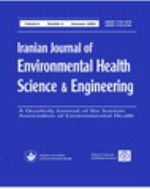
|
Iranian Journal of Environmental Health, Science and Engineering
Iranian Association of Environmental Health (IAEH)
ISSN: 1735-1979
Vol. 7, No. 1, 2010, pp. 15-24
|
 Bioline Code: se10002
Bioline Code: se10002
Full paper language: English
Document type: Research Article
Document available free of charge
|
|
|
Iranian Journal of Environmental Health, Science and Engineering, Vol. 7, No. 1, 2010, pp. 15-24
| en |
Effect Of Hydrophilic And Hydrophobic Organic Matter On Amoxicillin And Cephalexin Residuals Rejection From Water By Nanofiltration
Zazouli, M.A.; Ulbricht, M.; Nasseri, S. & Susanto, H.
Abstract
Antibiotics such as amoxicillin and cephalexin are a group of pharmaceutical compounds in human medicine practice that have been entered in water bodies. Presence of these compounds in the environment has raised concerns regarding the toxicity to aquatic organisms and the emergence of strains of antibiotic-resistant bacteria. Removal of these substances before entering the aquatic environment as well as water reuse plant is very important. The objective of this investigation was to evaluate the impact of hydrophilic and hydrophobic fractions of Natural Organic Matter (NOM) on the removal efficiency of cephalexin and amoxicillin, by using two different commercially available composite NF membranes (TFC-SR2 and TFC-SR3). In addition, the effect of NOM fractions on retention mechanism and permeates flux behavior was studied. Amoxicillin and cephalexin were used as models of antibiotics; alginate and humic acid were used as models of hydrophilic and hydrophobic fractions of NOM, respectively. It was observed that the rejection and permeate flux of amoxicillin and cephalexin were influenced by the membrane characteristics and properties of NOM. The results showed that as the alginate proportion was increased, the rejection improved. The permeate flux decreased with increasing alginate ratio. It was observed that the rejections of amoxicillin and cephalexin in TFC-SR2 were >97.3% and >95.8% in all experiments, respectively. In TFC-SR3, the rejection percentage were (95.9%-100%) and (86.1%-96.3%), respectively. Alginate and humic acid had synergistic effect on flux decline. In other words, increasing alginate concentration increased the rate and extent of flux reduction.
Keywords
Natural Organic Matter fraction, Nanofiltration, Antibiotic removal, Fouling, Amoxicillin, Cephalexin
|
| |
© Copyright 2010 - Tehran University of Medical Sciences Publications
Alternative site location: http://diglib.tums.ac.ir/pub/
|
|
